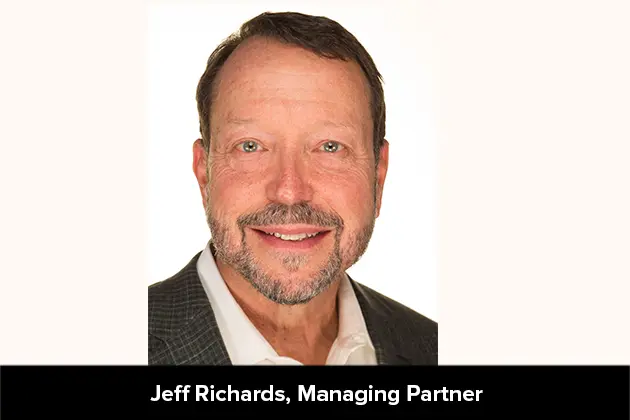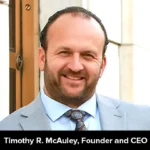In today’s tech driven economy, building a close alignment between IT and business is a daunting task. That’s where CIO Professional Services, LLC steps in.
As a 15-year-old IT strategy consulting firm, CIO Professional Services helps mid-size organizations seamlessly integrate modern IT technology into business to address a wide range of IT alignment and strategy issues. As seasoned CIOs, they help you remove barriers and improve return on IT investment, while advancing your personal success.
At the helm is Jeff Richards, Managing Partner of CIO Professional Services, LLC. An inspirational leader with the ability to develop successful business strategies to cultivate tangible results, Jeff leads the Professional Services team.
In a recent interview with The CEO Views, Jeff Richards talked about his business story and how he is driving unparalleled success to business through effective thought leadership.
Kindly take us through your entrepreneurial journey! What inspired you to pursue a leadership role in this industry?
I actually started my career in manufacturing operations. Then I got more interested in putting in systems than running factories. I joined Ernst & Young, and worked my way up the ladder until I found myself managing 5,000 people across Europe, Middle East and Africa.
Soon I realized that although I was making lots of money, the job was eating my life, I wasn’t dealing with clients and learning new things, which is why I went into consulting, and I certainly wasn’t having fun. So, I moved back home from Europe, took off with a couple of other EY guys and opened up a little shop where I could start solving client’s problems and stay on the leading edge again.
You are widely regarded as an inspirational thought leader. Can you share any of your main intellectual breakthrough ideas or initiatives that you have pioneered?
Consulting is generally based on figuring out what’s wrong and then determining how to fix it. To address the first half of this – figuring out what is wrong – most consultants start their engagements by completing an assessment. One of our innovations was in creating a much faster and more efficient way to do this.
Back in the 1990s, most consultants completed their assessments by doing one-on-one interviews with a long list of people from the client’s team and then synthesizing the results of these serial interviews. It was a time-consuming and challenging process.
What we did was use some commercially available software that enabled us to pull everyone into a virtual room at the same time, where we led highly facilitated group sessions. All participants needed was a phone line and internet connection, which was very innovative at the time.
Not only was this a much more efficient process, we actually found that we got much more accurate assessments of the current situation. As we walked them through the questions, participants would often feed upon each other’s remarks when someone hit upon something.
These more accurate assessments, in turn, made it easier for us to ensure that our recommended solutions were all about the business. Because one of our guiding doctrines has always been that the business case must come first.
What according to you is true thought leadership?
There’s a lot of theory out there, and a lot of unrewarded genius littering the Silicon Valley. Lots of people come up with thoughts and think, “Gee, I’m a great thinker!” But what’s the practical application? Will it work? Why would you want to do that? Who would buy that – and why?
To me, true thought leadership is seeing the practical ideas that others are not seeing. It’s the applications or opportunities hiding inside a situation that can and should be brought to life and implemented.
How do you reflect on your leadership journey?
My experiences gathered from my previous roles have provided a set of building blocks, perspectives and ways of understanding things that I bring to my firm and clients as a leader.
What I’ve seen is that until you have an experience base that you’ve built up from actually doing things in different cultures, you can’t provide true leadership. I have worked on three different continents and with 20 different cultures in 15 different countries. In addition to the expertise I developed through all this real-world experience, I believe this has made me a much better leader because it has given me a broader perspective and greater empathy for a greater range of cultures and capabilities.
Currently, innovation has become more of a need. What according to your understanding is innovation? Being an innovator yourself, how do you drive innovation?
A simple definition of innovation is it’s a new method, idea, product, etc. But just like with thought leadership, I believe that innovation must be practical to be of value. It must be driven by a need. Innovation for innovation’s sake is something that might be done in universities or think tanks that don’t need to generate revenues or reduce costs, but that’s not how it works in the business world.
The trite Silicon Valley answer to “how do you drive innovation” is to create a culture in which failure is acceptable, so that you can fail fast.
While I agree that you need to create a culture in which failure is acceptable, I drive innovation by recognizing that this empowerment does not mean permissiveness. You still must ensure that innovation is driven by a need. I always define the context, the boundary conditions from the standpoint of the problem that we’re trying to solve. Then I turn my team loose to innovate within that context.
In what ways has the company adjusted to the dynamic market demands, changing preferences, technology breakthroughs, and other industry changes?
In consulting, specifically in IT, you have to be able to see what’s coming next. What is the next big thing? That’s what we do. We always try to stay at the leading edge of technology advancements.
Technology is constantly evolving and so is the market demand for services. For example, 15 years ago clients were asking about if and how they should move to cloud, whereas today of course the big thing on everyone’s minds is AI, artificial intelligence.
What are the most important values you demonstrate as a leader? What do you look for when building a team?
Teddy Roosevelt said; “The best executive is the one who has sense enough to pick good people to do what he wants done, and self-restraint enough to keep from meddling with them while they do it.”
As a leader I understand that I am an enabler, not a director. After I set the context, my job is to ensure that everyone keeps working within that context, so that we focus on what we sold the client, not the 53 other things that a team member thinks the client also needs.
When building a team, I look for a diverse set of people. If I’m going to build a symphony orchestra I don’t need seven first violins. I want people who have a diversity of skills, perspectives and experience levels.
What are the pain points in your industry? How is your team specially equipped to solve those problems?
As I alluded to earlier, a big pain point in our industry is the need to constantly reskill in order to keep up with the newest technologies and advances.
Our team is specially equipped to do this because we’ve been staying at the leading edge of technology for decades. We have the experience and insight to be able to determine which waves to catch – i.e., which new technologies to adopt – and which to ignore.
What are your advice and tips for emerging thought leaders?
Diverge and then converge. Get a broad breadth of exposure, and then pick something that you’re going to focus on. But always have your ears open and senses on for something that might be interesting.










